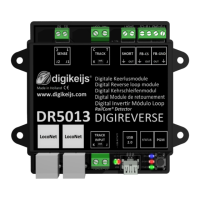DR5013 DIGIREVERSE
P 24
www.digikeijs.com
® R-Bus, B-Bus are trademarks which are registered in the name of Modelleisenbahn GmbH. XpressNet and RS-Bus is a trademark registered in the name of Lenz
Stand 2021-07-06
5.0 Connecon examples
In the 2-wire system, dierent polaries of the tracks meet at the turnout of the reversing loop. If a vehicle now bridges the separaon points at the en-
trance or exit, a short circuit occurs. The ulmate DR5013 reversing loop module can be used to eliminate this problem. The connecon examples shown
here give an overview of how the DR5013 can be wired in dierent situaons and which sengs are necessary in the conguraon soware. The most
common opons are presented here, which are generally sucient.
Basically, the DR5013 module has three dierent modes (operang modes):
1. Current dierence measurement, also known as "short-circuit detecon". (Example 5.1,5.2)
2. Sensor controlled, "short-circuit free" with 4 sensor track secons. (Example 5.3)
3. Turnout controlled, "short-circuit free", the turnout posion controls the polarity of the reversing loop, or the reversing loop controls the turnout.
(Example 5.4, 5.5)
All return media events from the DR5013 (S0, S1, S2, S3, Track (T), Railcom®, short-circuit message etc.) are automacally sent to the central unit via Lo-
coNet® and can be evaluated there. If Loconet® is not available, this funcon is of course omied.
Aenon! In all the connecon examples shown here, you must make sure that the DR5013 (track input) is sup-
plied with the same control unit or booster as the track secons S0 and S3!
Please note that there are of course further possibilies and special cases which cannot be shown here!

